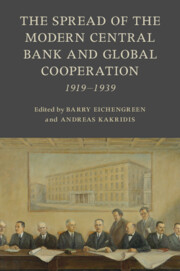Book contents
- The Spread of the Modern Central Bank and Global Cooperation
- Studies in Macroeconomic History
- The Spread of the Modern Central Bank and Global Cooperation
- Copyright page
- Contents
- Figures
- Tables
- Editors and Contributors
- Preface
- Part I General
- Part II Specific
- 5 Central Bank Policy under Foreign Control
- 6 Sneaking Nationalization
- 7 The Bank of Poland and Monetary Policy during the Interwar Period
- 8 From Banking Office to National Bank
- 9 ‘Nobody’s Child’
- 10 The Bulgarian National Bank, 1926–1935
- 11 Macroeconomic Policies and the New Central Bank in Turkey, 1929–1939
- 12 Latin American Experiments in Central Banking at the Onset of the Great Depression
- 13 Central Banks in the British Dominions in the Interwar Period
- 14 Central Banking and Colonial Control
- Index
- References
9 - ‘Nobody’s Child’
The Bank of Greece in the Interwar Years
from Part II - Specific
Published online by Cambridge University Press: 02 November 2023
- The Spread of the Modern Central Bank and Global Cooperation
- Studies in Macroeconomic History
- The Spread of the Modern Central Bank and Global Cooperation
- Copyright page
- Contents
- Figures
- Tables
- Editors and Contributors
- Preface
- Part I General
- Part II Specific
- 5 Central Bank Policy under Foreign Control
- 6 Sneaking Nationalization
- 7 The Bank of Poland and Monetary Policy during the Interwar Period
- 8 From Banking Office to National Bank
- 9 ‘Nobody’s Child’
- 10 The Bulgarian National Bank, 1926–1935
- 11 Macroeconomic Policies and the New Central Bank in Turkey, 1929–1939
- 12 Latin American Experiments in Central Banking at the Onset of the Great Depression
- 13 Central Banks in the British Dominions in the Interwar Period
- 14 Central Banking and Colonial Control
- Index
- References
Summary
Established at the behest of the League of Nations to help the country secure an new international loan, the Bank of Greece was regarded with a mixture of suspicion and hostility from its very foundation. The onset of the Great Depression tested its commitment to defending the exchange rate against domestic pressure to reflate the economy. Its policy response has been criticized as being ineffectual and even detrimental: the bank is said to have been unduly orthodox and restrictive, not only during but also after the country’s eventual exit from the gold exchange standard. This chapter combines qualitative and quantitative sources to revisit the Bank of Greece’s decisions during the Great Depression. It argues that monetary policy was neither as ineffective nor as restrictive as its critics suggest, thanks to a continued trickle of foreign lending but also to the Bank’s own decision to sterilize foreign exchange outflows. It reappraises Greece’s attempt to maintain the gold standard after sterling’s devaluation, a decision routinely denounced as a policy mistake. Finally, it challenges the notion that Greece constitutes an exception to the rule that countries that shed their ‘golden fetters’ faster recovered earlier.
Keywords
- Type
- Chapter
- Information
- The Spread of the Modern Central Bank and Global Cooperation1919–1939, pp. 225 - 267Publisher: Cambridge University PressPrint publication year: 2023



